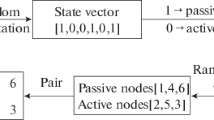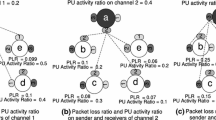Abstract
Broadcasting is an important phenomenon, because it serves as simplest mode of communication in a network, via which each node disseminates information to their neighboring nodes simultaneously. Broadcasting is widely used in various kind of networks, such as wireless sensor networks, wireless networks, and ad-hoc networks. Similarly, in cognitive radio networks (CRNs), broadcasting is also used to perform many tasks including neighbor discovery, spectrum mobility, spectrum sharing, and dissemination of message throughout the network. The traditional approach that has been used as broadcasting in CRNs is simple flooding in which a message is disseminated in the network without any strategy check. Simple flooding can cause major setbacks in the network, such as excessive redundant rebroadcasts, and collision drops which collectively are termed as broadcast storm problem. To reduce the effects of broadcast storm problem in wireless networks, we propose and compare four broadcasting strategies for cognitive radio networks in this paper. These four strategies are: (1) probability based, (2) counter based, (3) distance based, and (4) area based. Extensive NS-2 based simulations are carried out on different threshold values for each broadcasting strategy. After experimental evaluation, it is demonstrated that counter based broadcasting surpasses other broadcasting strategies by achieving maximum delivery ratio of 60% and by decreasing redundant rebroadcasts and collision drops up to 44 and 37% respectively.










Similar content being viewed by others
References
Mitola, J. (2009). Cognitive radio architecture evolution. Proceedings of the IEEE, 97(4), 626–641.
Jankuloska, B., Pavloski, M., Zahariev, M., Atanasovski, V., & Gavrilovska, L. (2010). Efficient spectrum utilization: A cognitive approach. In 8th international conference on communications (COMM) (pp. 527–530).
Zhao, N., Yu, F. R., Sun, H., & Li, M. (2016). Adaptive power allocation schemes for spectrum sharing in interference-alignment-based cognitive radio networks. IEEE Transactions on Vehicular Technology, 65(5), 3700–3714.
Saleem, Y., & Rehmani, M. H. (2014). Primary radio user activity models for cognitive radio networks: A survey. Journal of Network and Computer Applications, 43, 1–16.
Xie, H., Wang, B., Gao, F., & Jin, S. (2016). A full-space spectrum-sharing strategy for massive mimo cognitive radio systems. IEEE Journal on Selected Areas in Communications, 34(10), 2537–2549.
Zhang, R., Gao, F., & Liang, Y.-C. (2010) Cognitive beamforming made practical: Effective interference channel and learning-throughput tradeoff. IEEE Transactions on Communications, 58(2), 706–718.
Wang, B., & Liu, K. R. (2011). Advances in cognitive radio networks: A survey. IEEE Journal of Selected Topics in Signal Processing, 5(1), 5–23.
Chembe, C., Noor, R. M., Ahmedy, I., Oche, M., Kunda, D., & Liu, C. H. (2017). Spectrum sensing in cognitive vehicular network: State-of-art, challenges and open issues. Computer Communications, 97, 15–30.
Rehmani, M. H., Viana, A. C., Khalife, H., & Fdida, S. (2013). SURF: A distributed channel selection strategy for data dissemination in multi-hop cognitive radio networks. Computer Communications, 36(10), 1172–1185.
Ahmad, A., Ahmad, S., Rehmani, M. H., & Hassan, N. U. (2015). A survey on radio resource allocation in cognitive radio sensor networks. IEEE Communications Surveys & Tutorials, 17(2), 888–917.
Li, X., Zhao, N., Sun, Y., & Yu, F. R. (2016). Interference alignment based on antenna selection with imperfect channel state information in cognitive radio networks. IEEE Transactions on Vehicular Technology, 65(7), 5497–5511.
Yong, T., Yu, X., Jun, Z., & Wenyong, W. (2010). A survey on broadcast in wireless sensor networks. In 2nd international conference on information science and engineering (ICISE) (pp. 4324–4331). IEEE.
Kitajima, S., Yoshihisa, T., Ogawa, T., Hara, T., & Nishio, S. (2009). A broadcast-based data gathering method considering energy consumption for sensor networks. In Tenth international conference on mobile data management: Systems, services and middleware, MDM (pp. 536–541).
Rashid, B., Rehmani, M. H., & Ahmad, A. (2016). Broadcasting strategies for cognitive radio networks: Taxonomy, issues, and open challenges. Computers & Electrical Engineering, 52, 349–361.
Zhong, X., Lu, R., & Li, L. (2016). Social-based broadcast in cognitive radio networks: A network coding perspective. In IEEE international conference on Internet of Things (iThings) and IEEE green computing and communications (GreenCom) and IEEE cyber, physical and social computing (CPSCom) and IEEE smart data (SmartData) (pp. 441–444).
Tseng, Y.-C., Ni, S.-Y., Chen, Y.-S., & Sheu, J.-P. (2002). The broadcast storm problem in a mobile ad hoc network. Wireless Networks, 8(2/3), 153–167.
Kondareddy, Y. R. & Agrawal, P. (2008). Selective broadcasting in multi-hop cognitive radio networks. In Sarnoff symposium (pp. 1–5). IEEE.
Chang, D., Cho, K., Choi, N., Choi, Y., et al. (2012). A probabilistic and opportunistic flooding algorithm in wireless sensor networks. Computer Communications, 35(4), 500–506.
Sasson, Y., Cavin, D., & Schiper, A. (2003). Probabilistic broadcast for flooding in wireless mobile ad hoc networks. In Wireless Communications and Networking WCNC (Vol. 2, pp. 1124–1130). IEEE.
Qing-wen, W., Hao-shan, S., & Qi, Q. (2010). A dynamic probabilistic broadcasting scheme based on cross-layer design for manets. International Journal of Modern Education and Computer Science, 2(1), 40.
Bani-Yassein, M., Ould-Khaoua, M., Mackenzie, L. M., & Papanastasiou, S. (2006). Performance analysis of adjusted probabilistic broadcasting in mobile ad hoc networks. International Journal of Wireless Information Networks, 13(2), 127–140.
Yassein, M. B., Khalaf, M. B., & Al-Dubai, A. (2010). A performance comparison of smart probabilistic broadcasting of ad hoc distance vector (aodv). Journal of Supercomputing, 53(1), 196–211.
Shah-Mansouri, H., Khalaj, B. H., Pakravan, M. R., & Khodaian, A. M. (2009). Counter-based broadcasting: Modeling and performance analysis in csma-based wireless networks. In IEEE 20th international symposium on personal, indoor and mobile radio communications (pp. 2186–2191).
Yassein, M. B., Nimer, S. F., & Al-Dubai, A. Y. (2011). A new dynamic counter-based broadcasting scheme for mobile ad hoc networks. Simulation Modelling Practice and Theory, 19(1), 553–563.
Ertuğrul, O., & Buzluca, F. (2011). An efficient broadcasting scheme for cognitive radio ad hoc networks. In Proceedings of the 4th international conference on cognitive radio and advanced spectrum management (p. 5). ACM.
Mohammed, A., Ould-Khaoua, M., & Mackenzie, L. (2007). An efficient counter-based broadcast scheme for mobile ad hoc networks. Formal methods and stochastic models for performance evaluation (pp. 275–283).
Izumi, S., Matsuda, T., Kawaguchi, H., Ohta, C., & Yoshimoto, M. (2007). Improvement of counter-based broadcasting by random assessment delay extension for wireless sensor networks. In International conference on sensor technologies and applications, SensorComm (pp. 76–81). IEEE.
Alhadidi, B., Alzyoud, F. Y., Alawin, A., & Aldabbas, H. (2014). A moderated distance based broadcasting algorithm for manets. International Journal of Computer and Communication Engineering, 3(6), 398.
Ruiz, P., & Bouvry, P. (2010). Enhanced distance based broadcasting protocol with reduced energy consumption. In International conference on high performance computing and simulation (HPCS) (pp. 249–258).
Ruiz, P., & Bouvry, P. (2012). On the improvement of the enhanced distance-based broadcasting algorithm. International Journal of Communication Networks and Distributed Systems, 9(3–4), 225–246.
Ruiz, P., Dorronsoro, B., Valentini, G., Pinel, F., & Bouvry, P. (2012). Optimisation of the enhanced distance based broadcasting protocol for manets. The Journal of Supercomputing, 62(3), 1213–1240.
Cartigny, J., & Simplot, D. (2003). Border node retransmission based probabilistic broadcast protocols in ad-hoc networks. In Proceedings of the 36th annual Hawaii international conference on system sciences (p. 10).
Ovalle-Martínez, F. J., Nayak, A., Stojmenovic, I., Carle, J., & Simplot-Ryl, D. (2006). Area-based beaconless reliable broadcasting in sensor networks. International Journal of Sensor Networks, 1(1–2), 20–33.
Kim, J.-s., Zhang, Q., & Agrawal, D. P. (2004). Probabilistic broadcasting based on coverage area and neighbor confirmation in mobile ad hoc networks. In Global telecommunications conference workshops (pp. 96–101).
Park, K., Song, M., & Kong, K.-S. (2005). Data dissemination model for location-based services. In IEEE sixth international conference on parallel and distributed computing, applications and technologies. PDCAT (pp. 186–190).
Chang, C.-Y., Shih, K.-P., & Lee, S.-C. (2004). Zbp: A zone-based broadcasting protocol for wireless sensor networks. In IEEE 18th international conference on advanced information networking and applications, AINA (Vol. 1, pp. 84–89).
Kalpana, G., & Punithavalli, M. (2012). Reliable broadcasting using efficient forward node selection for mobile ad-hoc networks. The International Arab Journal of Information Technology, 9(4), 299–305.
Mitola, J. (1999). Cognitive radio for flexible mobile multimedia communications. In IEEE international workshop on mobile multimedia communications, (MoMuC’99) (pp. 3–10).
Amjad, M., Akhtar, F., Rehmani, M. H., Reisslein, M., & Umer, T. (2017). Full-duplex communication in cognitive radio networks: A survey. IEEE Communications Surveys & Tutorials, 19(4), 2158–2191.
Wu, T.-Y., & Liao, W. (2013). Time-efficient broadcasting in cognitive radio networks. In Global communications conference (GLOBECOM), 2013 IEEE (pp. 1191–1196). IEEE.
Khan, U. U., Dilshad, N., Rehmani, M. H., & Umer, T. (2016). Fairness in cognitive radio networks: Models, measurement methods, applications, and future research directions. Journal of Network and Computer Applications, 73, 12–26.
Khan, A. A., Rehmani, M. H., & Reisslein, M. (2016). Cognitive radio for smart grids: Survey of architectures, spectrum sensing mechanisms, and networking protocols. IEEE Communications Surveys & Tutorials, 18(1), 860–898.
Arachchige, C. L., Venkatesan, S., Chandrasekaran, R., & Mittal, N. (2011). Minimal time broadcasting in cognitive radio networks. ICDCN, 11, 364–375.
Htike, Z., & Hong, C. S. (2013). Broadcasting in multichannel cognitive radio ad hoc networks. In Wireless communications and networking conference (WCNC) (pp. 733–737). IEEE.
Huang, P., Liu, C.-J., Yang, X., & Xiao, L. (2015). Efficient broadcast on fragmented spectrum in cognitive radio networks. In IEEE conference on computer communications (INFOCOM) (pp. 145–153).
Bukhari, S. H. R., Rehmani, M. H., & Siraj, S. (2016). A survey of channel bonding for wireless networks and guidelines of channel bonding for futuristic cognitive radio sensor networks. IEEE Communications Surveys & Tutorials, 18(2), 924–948.
Akyildiz, I. F., Lee, W.-Y., Vuran, M. C., & Mohanty, S. (2008). A survey on spectrum management in cognitive radio networks. IEEE Communications magazine, 46(4), 40–48.
Ozger, M., & Akan, O. B. (2016). On the utilization of spectrum opportunity in cognitive radio networks. IEEE Communications Letters, 20(1), 157–160.
Al-Mathehaji, Y., Boussakta, S., Johnston, M., & Fakhrey, H. (2015). CRBP: A broadcast protocol for cognitive radio ad hoc networks. In IEEE International conference on communications (ICC) (pp. 7540–7545).
Bukhari, S. H. R., Siraj, S., & Rehmani, M. H. (2016). Pracb: A novel channel bonding algorithm for cognitive radio sensor networks. IEEE Access, 4, 6950–6963.
Rehmani, M. H., Viana, A. C., Khalife, H., & Fdida, S. (2011). Activity pattern impact of primary radio nodes on channel selection strategies. In Proceedings of the 4th international conference on cognitive radio and advanced spectrum management (p. 36).
Yuan, G., Grammenos, R. C., Yang, Y., & Wang, W. (2010). Performance analysis of selective opportunistic spectrum access with traffic prediction. IEEE Transactions on Vehicular Technology, 59(4), 1949–1959.
Kim, H., & Shin, K. G. (2008). Fast discovery of spectrum opportunities in cognitive radio networks. In 3rd IEEE Symposium on New Frontiers in Dynamic Spectrum Access Networks, DySPAN (pp. 1–12).
Zahmati, A. S., Fernando, X., & Grami, A. (2010). Steady-state markov chain analysis for heterogeneous cognitive radio networks. In IEEE Sarnoff symposium (pp. 1–5).
Kim, H., & Shin, K. G. (2008). Efficient discovery of spectrum opportunities with mac-layer sensing in cognitive radio networks. IEEE Transactions on Mobile Computing, 7(5), 533–545.
Cognitive Radio Cognitive Network Simulator. [Online] (2013). http://faculty.uml.edu/Tricia_Chigan/Research/CRCN_Simulator.htm.
Bukhari, S. H. R., Siraj, S., & Rehmani, M. H. (2016). Ns-2 based simulation framework for cognitive radio sensor networks. Wireless Networks, 1–17.
Author information
Authors and Affiliations
Corresponding author
Rights and permissions
About this article
Cite this article
Hassan, M.U., Rehmani, M.H. & Faheem, Y. Performance evaluation of broadcasting strategies in cognitive radio networks. Wireless Netw 25, 999–1016 (2019). https://doi.org/10.1007/s11276-017-1647-2
Published:
Issue Date:
DOI: https://doi.org/10.1007/s11276-017-1647-2




